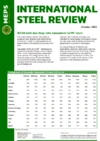Recovery in China could hold the key to global steel price fortunes
The downward trajectory of global steel prices, for both flat and long products, continued in June. Most steel producers, worldwide, will go into the traditional summer period – a seasonally slow time of year – with a sense of trepidation that the bottom of the current price cycle has yet to be reached.
The impact of China – which is responsible for around half of global steel production – can never be understated. Steel values, locally, are currently the lowest in the world. There was genuine hope that an easing of Covid-19 lockdowns in the major cities, such as Shanghai, would result in increased steel demand. This has yet to materialise.
MEPS’ reported China steel prices, in June, reduced by between two and four percent on average, month-on-month. Reinforcing bar values – a key indicator in the long product market – fell below RMB4000 per tonne, for the first time since February 2021.
China’s zero-tolerance approach to Covid-19 infections is weighing heavily on market confidence. Steel consumption is being curtailed, at short notice, in areas that report new virus cases.
Another signal of domestic demand weakness is the export strategies of Chinese steel manufacturers. Suppliers that may be benefiting from their greater access to cheap Russian-origin feedstock have a current thirst to sell extensively, overseas. MEPS understands that many producers are selling aggressively into key export markets, such as Southeast Asia and South Korea.
Stimulus measures
The Chinese authorities are taking a series of measures, in an attempt to stimulate domestic demand. In contrast with policies in the rest of the world, China cut interest rates, earlier in the year, to encourage activity. Local government schemes, offering incentives to replace existing cars or appliances, will also help to boost steel consumption.
MEPS notes tentative signs that China is targeting production cuts, in the second half of 2022. The authorities in many provinces have already declared their intention, publicly, to restrict steel output, to ensure that this year’s tonnages do not exceed those recorded in 2021. The implementation of such measures should strengthen the mills’ domestic pricing ambitions, while limiting their ability to negatively influence neighbouring markets via cheap exports.
The recent introduction of an export duty, in India, may also deny traditional steel exporters in that country the opportunity to offer material as competitively as they were previously.
Consequently, European and North American producers may take heart from any increase in import price offers, from traditional low-cost origins. This may provide them a timely, and much needed pricing boost, as they return from their vacation periods, in July and August.

Source:
International Steel Review
The MEPS International Steel Review is an essential monthly publication, offering professional analysis and insight into carbon steel prices around the world.
Go to productRequest a free publication





